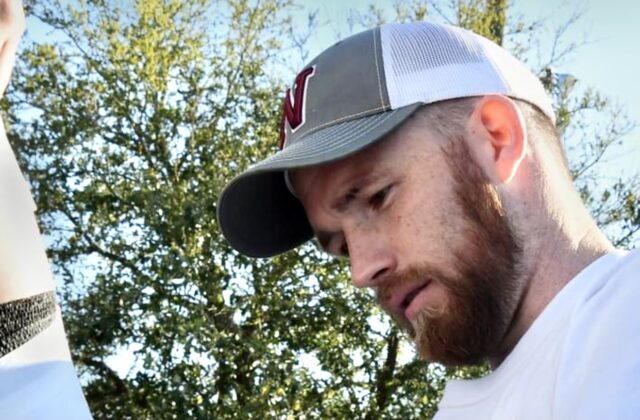
Story by Near Post Sports
The first line of defense of injury prevention, and injury treatment, in Navarre High School’s sports program is a 30-year-old certified athletic trainer.
Alan Ray – who hails from a small town just outside of Alexander City, Alabama – has served the school full-time via the Andrews Institute for nearly five years. And that time is coming to a close April 16. Ray accepted a position outside of the athletic trainer community to pursue other career opportunities and personal goals. BUT, you might see him filling in with the teams until a permanent replacement is assigned.
The former athlete – Alan played football, basketball, and baseball for the Horse Bend High School Generals – graduated from Troy University and received his postgraduate degree from the University of North Georgia. He decided to become an athletic trainer, “because I like to help others, have a passion for sports, want to see others succeed in life, and work in a variety of settings with all types of athletes and skilled individuals.”
For anyone who follows the various teams at Navarre, Ray normally patrols the sideline tending to ailing players on both sides of the field: taping, icing, assessing, or rehabbing for both. “Athletic training is so much more than taping and making ice bags,” he said. “We are versatile in rehabilitation, emergency care, public relations, research, building relationships, bracing, sales. The list goes on and on.”
There’s a demanding schedule for his skills, no matter what season it is. “Depending on the time of year, my schedule changes,” he said. “Each day is different from the next. I get to school midafternoon and stock up my medical kit and taping table for the day. I then get necessary equipment out for rehabilitation sessions before practices and games. After physical therapy, if I have games, then I head over to the location (gym, field, etc.) about 15-30 minutes prior to tape, stretch, etc. I cover the games until the last one is over and have evaluated any injuries that may have occurred.”
It could be taxing for providing services for just one of the Raider squads. But he has responsibilities to cover ALL of the sports, which puts him in contact with nearly all the schools’ student-athletes. Multiple sports run consecutively – like this spring season has baseball, flag football, lacrosse, softball, track, tennis, and boys’ weightlifting. But he admits that the fall season creates his busiest time, due to football and the sheer number of players and practices involved.“Of course, with higher contact sports comes higher injury rate,” he said. “Keeping up with that and working with the coaching staff to hopefully decrease likelihood for injury – that’s the tricky part.”
Football season is also his favorite – practices four days a week with freshman, junior varsity, and varsity games, as well. “I enjoy the atmosphere of the sport, along with the ability of making quick decisions to help an athlete stay on the field and play the game at their best ability,” the red-headed sports fan said. “The high demand of the sport keeps me on my toes, plus I love coming up with innovative techniques both on/off the field w/ coaching staff, parents, and athletes to help them improve in the short and long term.”
The football team is the only one he travels with for away games, unless Navarre makes it deep into the playoffs. Then he makes the trip, as schedules allow.“Every sport has specific needs, and I think that’s what keeps work in the field so interesting,” Ray said. “A lot of the time and effort goes into each sport honestly to some extent. The more contact driven the sport is, the more demanding, primarily because of what it takes to keep everyone healthy – lots of rehab, tape, ice, mental health.”Outside of what people typically think we do – taping & icing, I like to actively utilize my tool of knowledge in rehabilitation to help both injured athletes and athletes that need to maintain strength and mobility.”
Of all the rewards that come with the job, he said it’s not chasing his own achievements. “At the end of the day it is so rewarding to witness an athlete return to play post injury and watch them succeed. That’s what it’s about, helping people to succeed.”
May success also come to you in the new career, Alan.
All photos by Stu Camp










